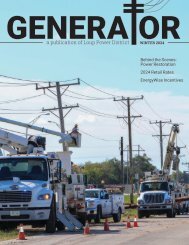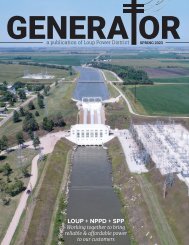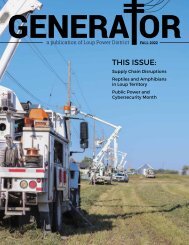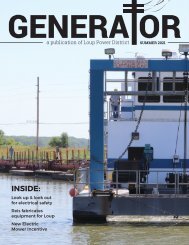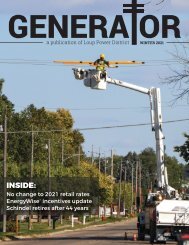Generator—Summer 2022
In this edition: A Californian retraces Horatio's Drive and the Lincoln Highway in a 1964 Volkswagon Bus converted to run on electricity; an underwater inspection at the Monroe Powerhouse; summer safety tips; and more.
In this edition: A Californian retraces Horatio's Drive and the Lincoln Highway in a 1964 Volkswagon Bus converted to run on electricity; an underwater inspection at the Monroe Powerhouse; summer safety tips; and more.
Create successful ePaper yourself
Turn your PDF publications into a flip-book with our unique Google optimized e-Paper software.
Horatio’s Drive<br />
& The Lincoln Highway<br />
an electric American adventure<br />
Jack Smith pushed a skateboard across<br />
America four times.<br />
Then he rode an electric skateboard from<br />
Oregon to Washington, D.C.<br />
That might be enough adventure for most<br />
people. But Smith isn’t like most people.<br />
“I’ve been attracted to crossing the<br />
country in different ways,” he said.<br />
In early June, Loup Power District<br />
employees saw a vintage Volkswagen van<br />
pull up to the electric vehicle charging<br />
station in the parking lot.<br />
They had to investigate. This was indeed<br />
“different.”<br />
And so, we met Smith and his childhood<br />
friend, Larry Newland, and asked them to<br />
share their stories.<br />
HORATIO’S DRIVE<br />
Last year, Smith sat down to watch the<br />
Ken Burns documentary “Horatio’s Drive” at<br />
his home in California.<br />
It tells the story of Dr. Horatio Nelson<br />
Jackson. He was at San Francisco’s University<br />
Club in May 1903 when he made a<br />
$50 bet (equivalent to more than $1,500<br />
today) that he could cross the country in an<br />
automobile.<br />
A few days later, he purchased a<br />
20-horsepower Winton touring car. He was<br />
31 years old with very little driving experience<br />
and no maps to follow. The country had<br />
only 150 miles of paved roads.<br />
Five days after the bet, he took off with<br />
Sewall K. Crocker, who served as travel<br />
companion, mechanic, and backup driver.<br />
A bull terrier named “Bud” joined them<br />
in Idaho. He was outfitted with goggles to<br />
protect his eyes as he helped watch the road.<br />
Most people doubted that the automobile<br />
had a future. But Jackson proved them<br />
wrong when he arrived in New York City 63<br />
days later.<br />
Smith was hooked on the story immediately.<br />
After he watched the video, he bought<br />
a book and delved into the story even more.<br />
Then, he decided it wasn’t enough for<br />
him to simply read about Horatio’s drive. He<br />
wanted to make it.<br />
“I told my wife, ‘I want to retrace this<br />
guy’s route, but I don’t want to do it in a<br />
regular vehicle.”<br />
Left: Horatio Nelson Jackson and Sewall Crocker on their cross-country journey in 1903. They traveled in a 20-hp Winton touring car.<br />
Right: The pair faced mechanical issues, navigational problems, and bad roads. Photos courtesy of Silver Special Collections, University of Vermont.<br />
SKATEBOARDS ACROSS AMERICA<br />
Most Americans have never traveled<br />
across the entire country. Smith has done<br />
it multiple times — but never in a “regular<br />
vehicle.”<br />
Back in 1976, at 19 years old, he and three<br />
friends became the first to skateboard across<br />
America, with sponsorship from a company<br />
called Roller Sports.<br />
They did so in leapfrog fashion, with each<br />
skater going about three miles at a time.<br />
In between, the skaters got a ride in their<br />
support car — a 1969 Firebird.<br />
Each guy skated a total of 35–50 miles<br />
daily, depending on the terrain. As a team,<br />
they could travel 150 miles on a good day.<br />
The trip from Oregon to Virginia took 32 days.<br />
“It was a great way to see the country,”<br />
Smith said. “You’re going so slow, you don’t<br />
miss anything.”<br />
If anything, the trip only expanded<br />
Smith’s love of skateboarding. He competed<br />
in the infamous “Signal Hill Speed Run” in<br />
Signal Hill, Calif., held from 1974–78.<br />
Participants in the race set world records<br />
in skatecars, topping out at almost 60 miles<br />
per hour on the hill with a 30-degree drop.<br />
The annual event ended when sponsors<br />
withdrew because it became too dangerous,<br />
with multiple life-threatening crashes.<br />
By 1984, the “new guys” on the skateboarding<br />
scene were tired of hearing all<br />
Smith’s stories. They wanted stories of their<br />
own, and asked if he would consider another<br />
cross-country trip.<br />
It didn’t take much convincing. The fourman<br />
team took on the task again, raising<br />
money for Multiple Sclerosis awareness<br />
along the way. The journey took 26 days.<br />
In 2003, Smith’s son, Jack, died of complications<br />
from Lowe Syndrome, a rare genetic<br />
disease. His father died of Alzheimer’s<br />
Disease in 2013.<br />
Smith made two more cross-country trips<br />
to raise funds and awareness for those conditions<br />
in the years they died.<br />
That fourth trip in 2003 included his<br />
younger son, Dylan. The 3,618-mile journey<br />
set a world record that was broken by British<br />
skateboarder David Cornthwaite in 2007.<br />
By 2018, Smith was referred to as a<br />
“skateboarding legend” by media outlets<br />
and his fellow peers.<br />
It might have been enough for most<br />
people. But again, Smith isn’t like most<br />
people.<br />
That year, he decided it was time for one<br />
more trip. But this time, he was going to go<br />
solo on an Inboard M1 electric skateboard.<br />
The 2,394-mile journey from Eugene,<br />
Oregon, to the steps of the Smithsonian<br />
Museum took 45 days.<br />
He was 61 years old.<br />
Story by Stacy Wemhoff<br />
Jeff French, Jack Smith, and Mike Filben pushed their<br />
4 | GENERATOR<br />
Jack Smith (left) and Larry Newland charged<br />
the Rust Bus at Loup Power District’s<br />
electric vehicle charging station on June 3.<br />
skateboards across the United States in 1976. Smith also<br />
crossed the country on an electric skateboard in 2018.<br />
Photos courtesy of Jack Smith.<br />
SUMMER <strong>2022</strong> | 5




